Range Deviation Pivots represent one of the core studies of the Fourth Dimension suite. Originally designed for use in the Index, Commodity, Bond and Forex space where my original background lies, the use of them principally on daily and short term charts remains valid on Stocks, but is for the far more active and largely professional trader.
For me, the most useful area for Range Deviation Pivots lies in understanding what the correct intraday timeframe to be trading from is. Their ability to dynamically shift with changes in volatility and range means that, when markets go crazy like at present, they enable the trader to keep volume and risk unchanged by systemically lowering the execution timeframe chart. Sixty minutes can seem like a lifetime in the current environment, so having the ability to know that you should be trading in a 1 minute timeframe is invaluable. Rewards go up, but risk is unchanged.
When I took the brief some years ago to manage a Private Fund in U.S stocks, I could take my experience and adapt in what was a reasonably leisurely existence as positions were held for the long term. However, the primary objective I was given was to build systems from fundamental data, as my paymasters were convinced that the secret to success was identifying sector rotation and the next area that would outperform the others. This was to be drilled down further to identifying which stocks would be the best performing ones within that sector.
This appeared to be a daunting task, and I was not wrong to think so. Thankfully, I did have a "eureka moment" deep into the project, but it was not what I'd have ever expected. In the two years of analysis on the multitude of measurements and calculation that can be utilized, I found that systems that could be built on a superficial level were very good, but the practicalities of execution and the buildup of exposure was simply unmanageable as time progressed. I would end up with too many positions, meaning that I would have to rob Peter to pay Paul - if I wanted to add a fresh stock, I would need to liquidate an existing one, which opened up a Pandora's box of problems about how this could be quantified and tested historically.
Thankfully, I was given a similar task using technical methods which was much more up my street. However, what soon became clear was the fact that my methods and studies, which had been honed and tuned to the arena I had always been involved, faced similar problems when applied to individual stocks. I had lived in a world of probably around 100 markets for both day trading and strategic positioning; now I faced a market of nearer to 4,000. I either had to devise a way of limiting my world which I was inherently against, or adapting my knowledge and experience of my studies to dramatically reduce the frequency of signals. Never was the saying "Less is More" as apt.
As I knew the multitude of applications that Range Deviation Pivots already provided, it was an obvious place to begin. The culmination of this work lies with the studies PowwerPlay and SlammDunk, plus Aggressive and Passive Range Relativity, which are based around patterns and relationships of Range Deviation Pivot values.
That said, Range Deviation Pivots have their own independent uses. The calculation differs from standard Pivot theory in that it computes the range over the last 22 periods. It takes that average and, when the bar opens, it fixes 1, 2 and 3 standard deviations beyond that opening point. This means that the values are fixed and, therefore, enable you to be proactive. From that premise, there is an added variable that analyses the trend. This means that the deviations above and below are not symmetrical. If the trend is down, then the pivots below will be further apart and vice versa - this will be amplified if overall range has expanded as well in the recent past. This allows the current trend to breathe and makes the valuation of an extreme (which is qualified by reaching the 3rd Deviation) more difficult to achieve.
Originally designed for daily charts, Range Deviation Pivots possess the ability to visualize higher timeframe charts' limits of range to as high as semi-annual, providing there is sufficient data. However, my primary focus normally concentrates on the monthly and quarterly levels.
The first application looks to quantify an extreme when the trend has already developed. The chart below is a weekly of Microsoft (MSFT). There are two circles, the first of which marks the point when price hit the third deviation of an extreme on a monthly basis. The trend was embryonic in nature and it simply capped the trend for a couple of months. The second circle is far more important. It marks a far greater extreme, and the top, as by that time each monthly deviation was $10 apart in contrast to just $3.50 previously.
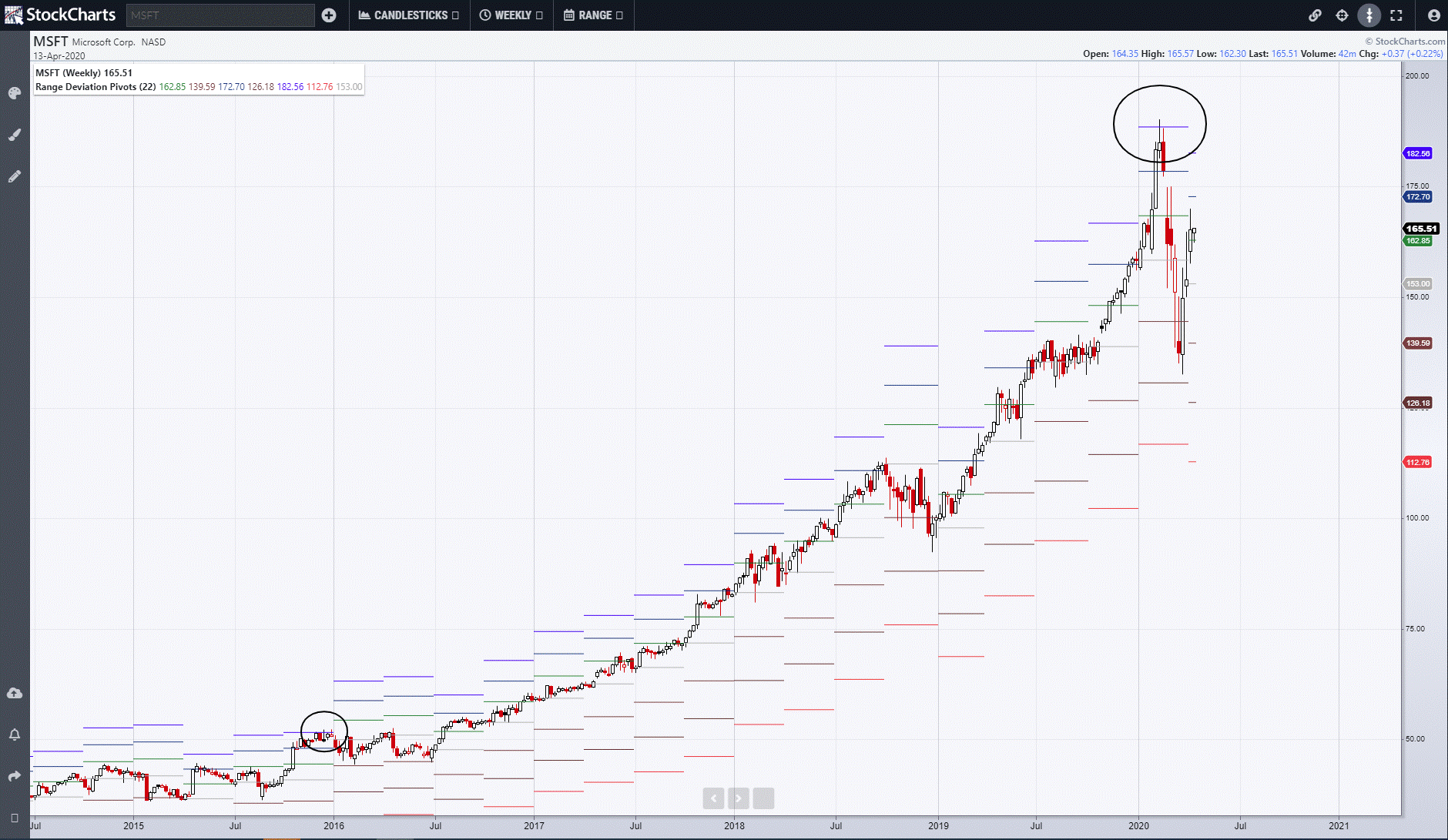
The next chart is of Campbell's (CPB). News of the hoarding of food supplies led to an announcement of record sales. Price spiked, but it was obvious that this was just an example of sales being artificially pushed up. This stock tends to be mean-reverting, and so the semi-annual 3rd deviation above was a major extreme. It is worth pointing out that, historically, Consumer Staples has been the Number 1 performing sector. Logic would suggest this would be in a bear market, when in fact it led the market higher through the spring of 2016, when the Dow went from 15,500 to over 18,000.
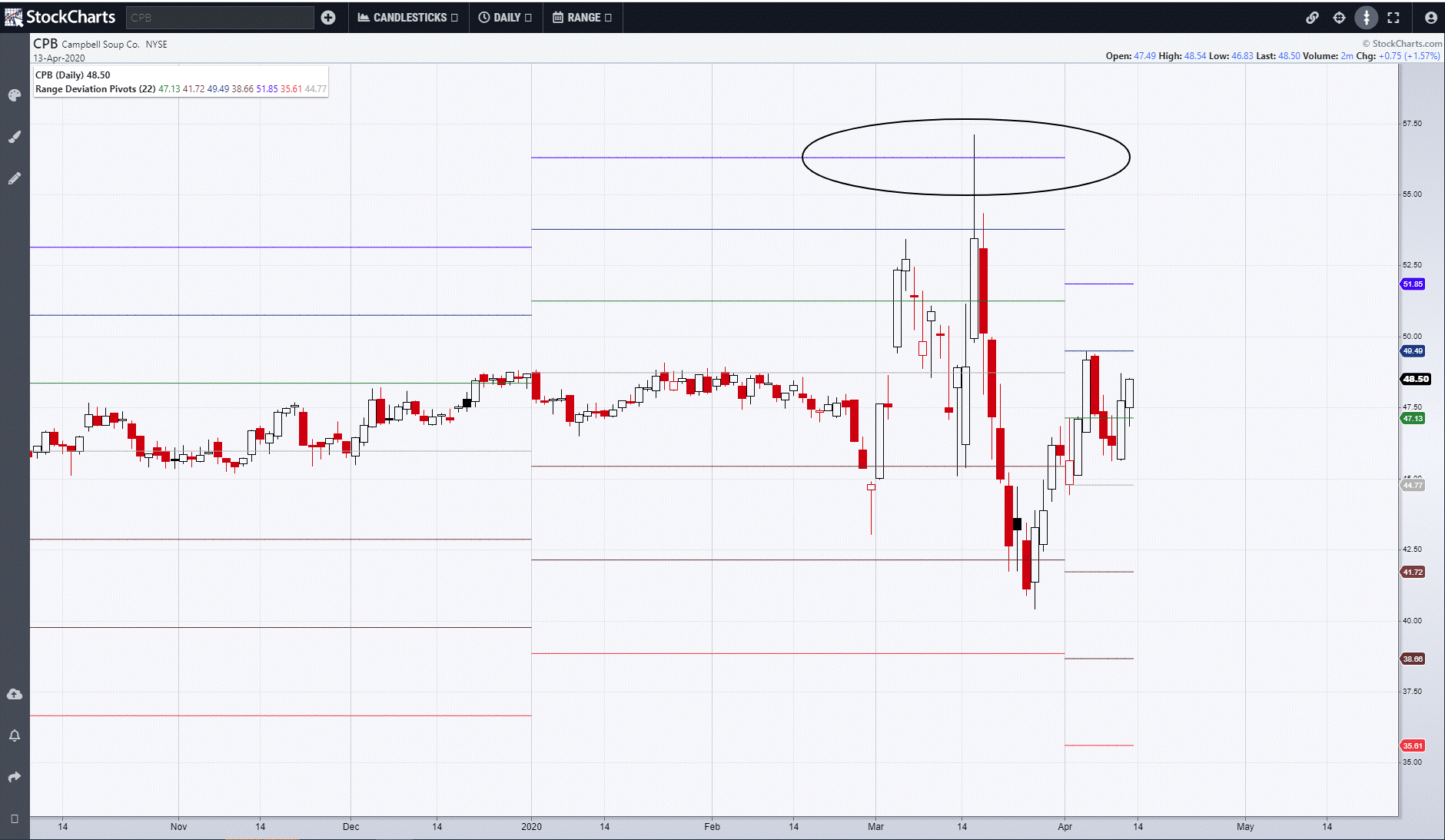
When a stock is typically mean-reverting, the monthly extremes come into play more often. Once again, Campbell's posted a high and a low in the recent past, as circled.
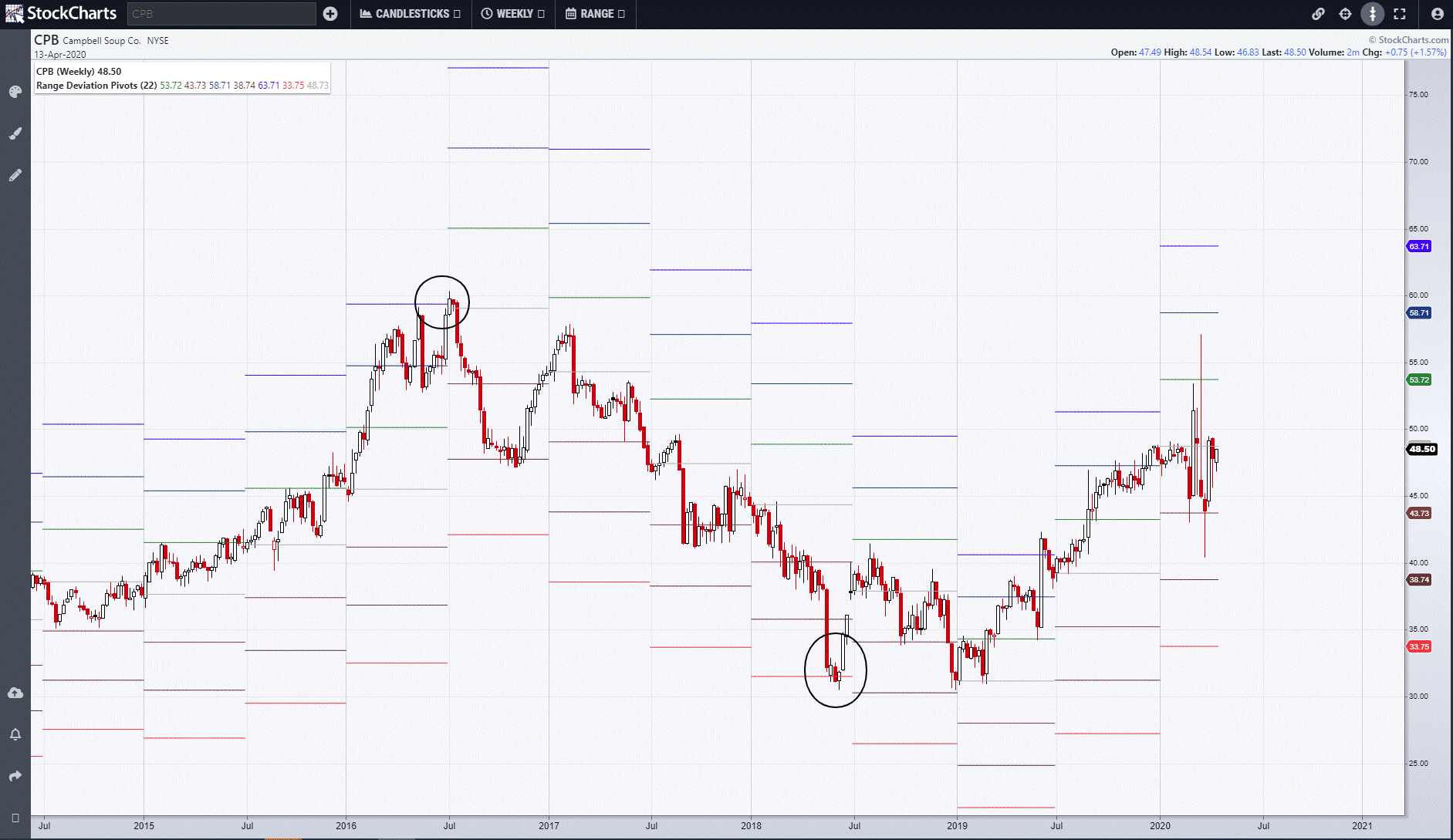
Whilst looking for sectors that will perform is one conundrum (my solution is to look at the bottom 10 in current performance), there are times when a view can simply be taken. Although sales have been frontloaded in Consumer Staples, there are still areas of interest. On a fundamental basis, my first ports of call are Earnings and Sales growth. At the top of the tree was Newel Brands (NWL) on an Earnings Per Share Growth basis. I was somewhat surprised when the chart came up, but closer inspection showed that while it is classed as a Staple, much of what is produces will still be hit. This may be so, but the market can easily rationalize any strength in the stock, with hindsight-based commentaries that would likely focus on the fact that it was in an area likely to do better than other consumer-sensitive companies. Whatever the rationalization, of far more importance is the fact that it bottomed out perfectly at the monthly extreme.
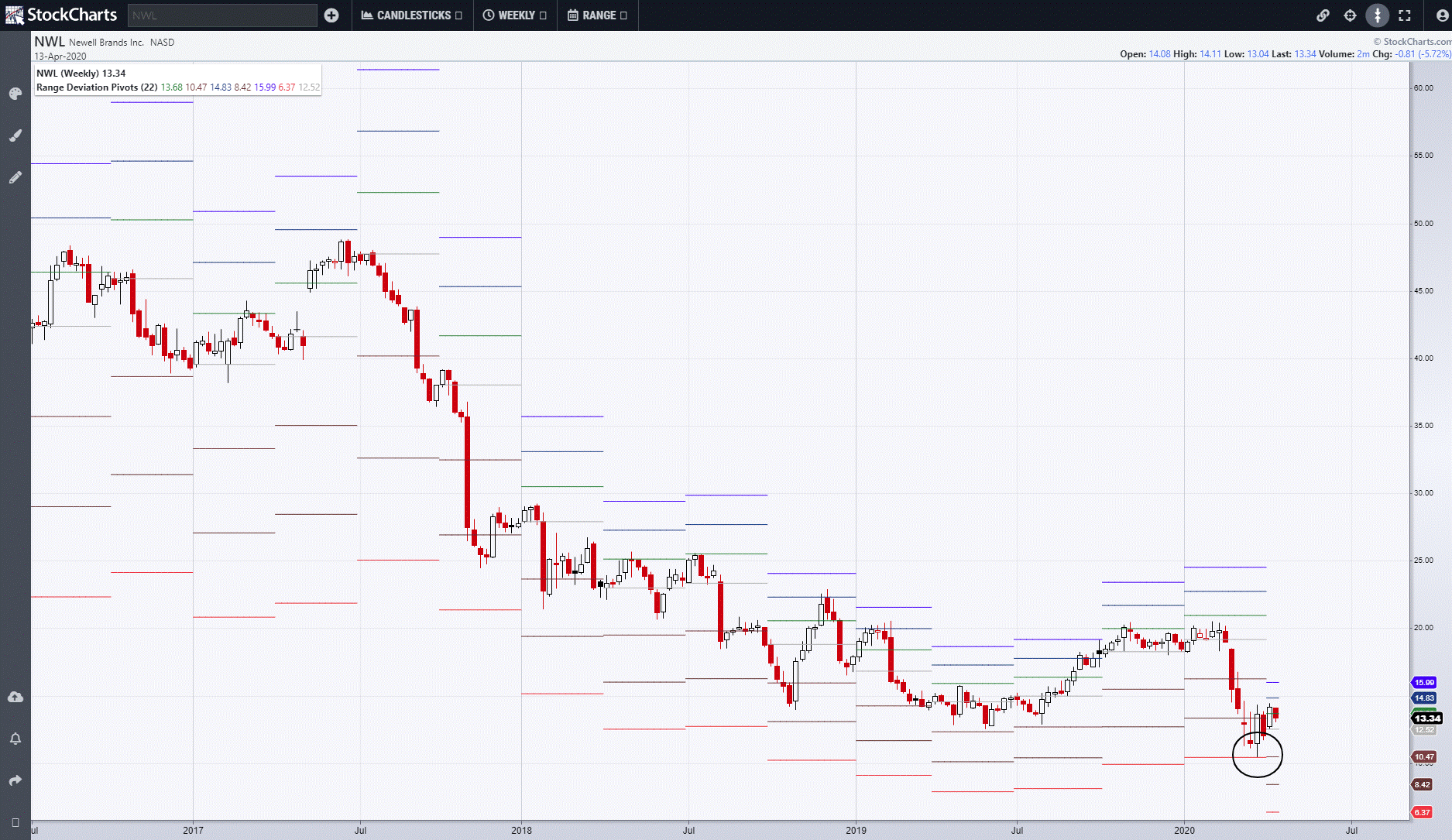
In terms of execution and trade type, there are a few options if looking to instigate a position. One huge advantage when looking for stocks to short in order to have a more balanced book is the fact that, when a stock is performing well, it is usually relatively easy to borrow the stock and cheaper to finance than when a stock is falling. Once any downtrend develops in a stock, it is often impossible to borrow at all.
The option market can also be used if looking for less risk by buying options, while if you're in an existing long position, the extreme can be used to at least partially exit with a pre-entered limit order, or you can grant short dated calls. At the very least, when an extreme is reached, the stock should stop and enjoy a period of reflection, enabling you to receive the premium. The example below is on a weekly of Duke Energy (DUK) with the Quarterly Pivots. The first circle shows that stock retraced for a month, then took nearly 3 months to make new highs.
The recent slump saw it bottom out perfectly at the 3rd Deviation extreme, as circled the second time. Closer inspection of both signals shows that the first went just 1 cent above the target, whilst the second stopped 1 cent from the target. This highlights the need to give these levels some wiggle room, as they can be too accurate, so place any orders just ahead of the levels.
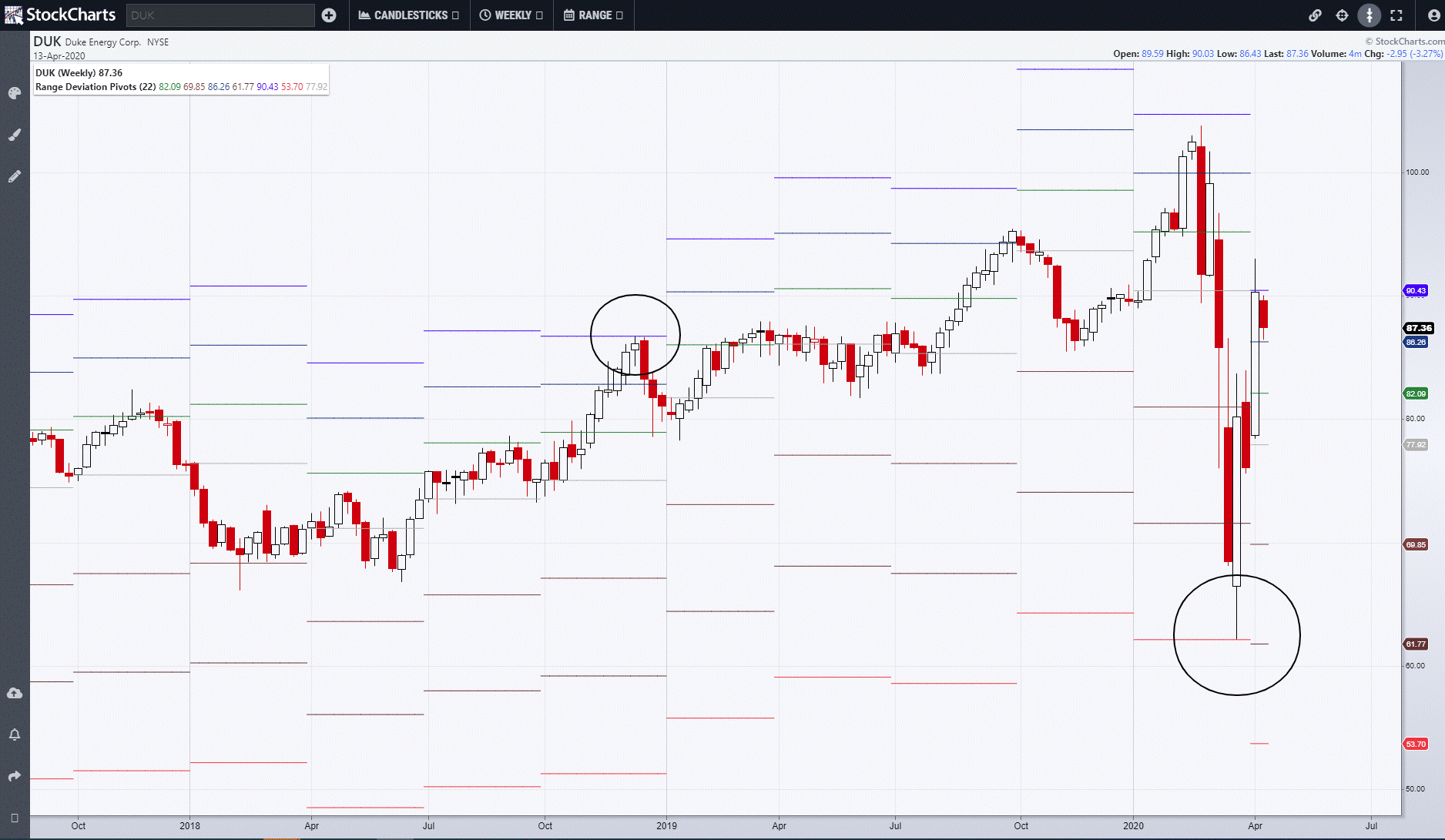
The final chart is once again of Duke Energy on a daily chart with Quarterly Deviations. This time, I have added the Signals study. An explanation of its basic premise is available in my first article.
The day after hitting its extreme, we had the added bonus of a positive signal appearing. Armed with the knowledge that an extreme has been reached, that would also allow for a position to be opened if not already involved. If the stock has already been bought at the extreme, it opens up the possibility to use the signal as a pyramid trade, but increases risk (pink stop loss line below). In terms of where profits can be taken, signals will produce automatic partial exits, as they did when the number 1 appeared above a candle (note the previous long signal produced 5 exits before hitting the stop loss at number 6). You also have the tools to look for your own profit targets with Peak Range and Expansion, and of course the extremes from the Range Deviation Pivots. Price hit the quarterly extreme in rapid fashion at 90.43 (second circle) from an extreme low at 62.13 in just 12 sessions.
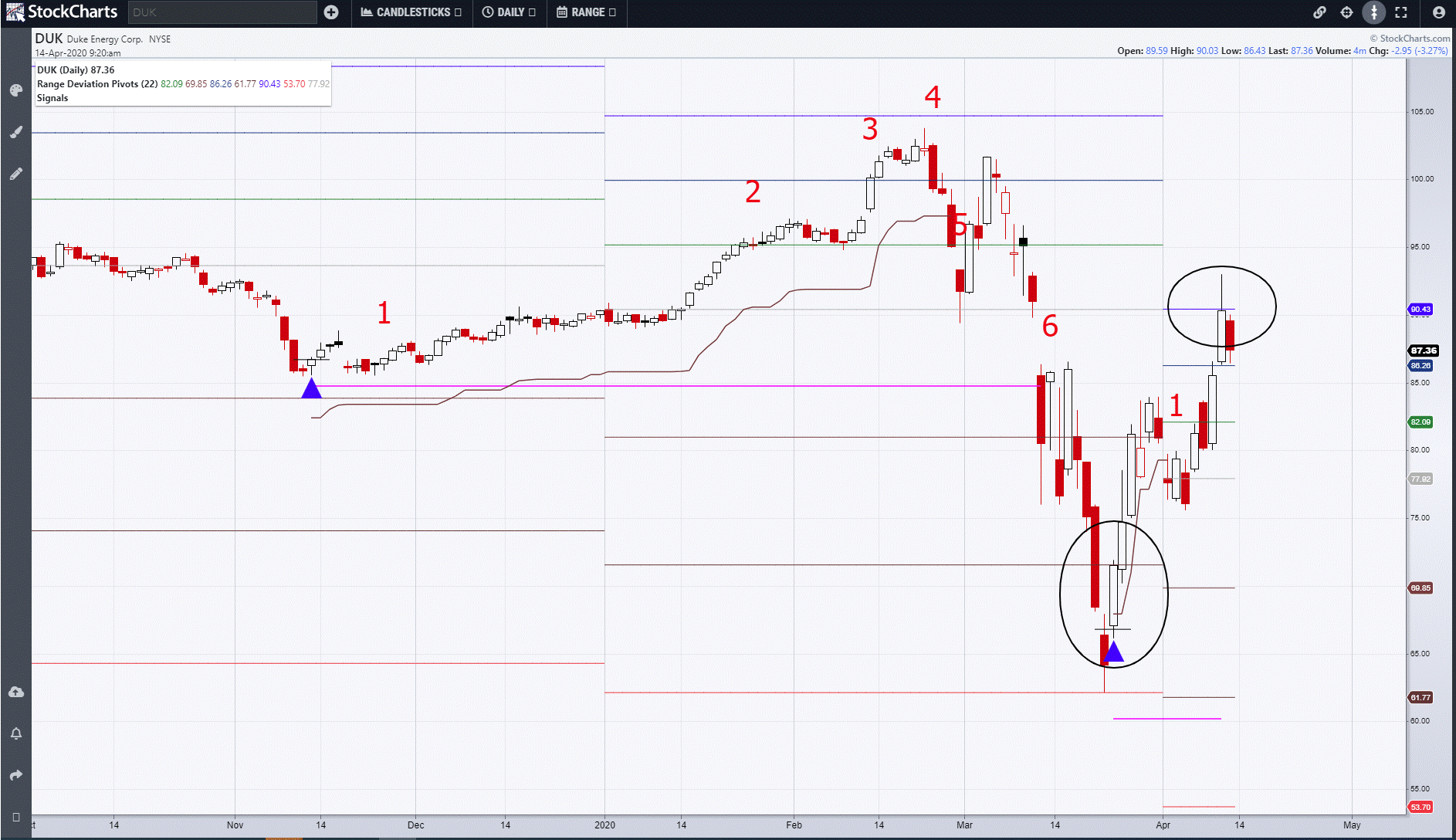
A huge advantage of using Range Deviation Pivots is the fact that the values are fixed at the opening of each period. Their proactive nature means that there is ample time to graze through stocks that are of interest. I normally look at monthlies at the end of week 2 and quarterlies 6 weeks in. This allows you to place the stocks on your watchlist and begin to get a flavor to how they perform against their overall market peers, but, more importantly, allows you to place price alerts on your StockCharts software so that you are not missing the opportunity when it arrives.
I can be contacted at shaun.downey@aol.com to answer any questions.
Shaun Downey
